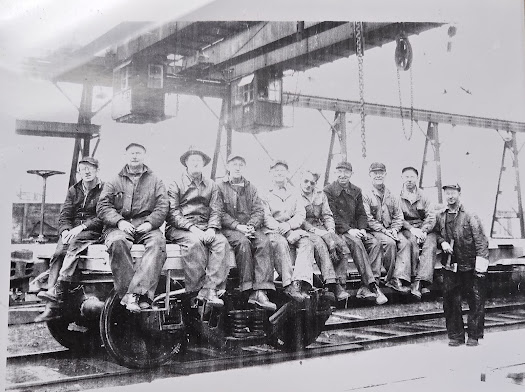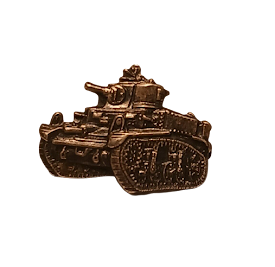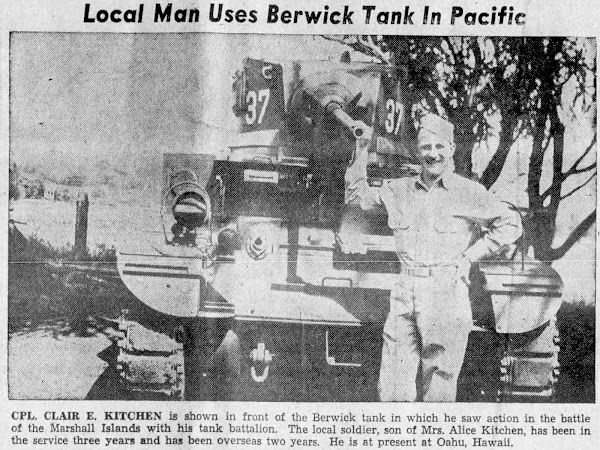1,000th Tank Parade, August 2nd 1941, Berwick PA
During World War II the American Car & Foundry in Berwick was transformed into a facility to build tanks for the War.
"Not in the great automobile city of Detroit, nor in the steel center of Pittsburgh, but here in the small Pennsylvania community of 14,000 today are being built the tanks for America's mechanized forces. For Berwick is now the "Tank Center Of The U.S.A." " - June 1941, Central Press newspaper article.
By the end of the war years it's claimed that Berwick built more than 15,000 Stuart tanks and earned Berwick a place on Hitler's list of places in the US that he wanted to bomb.
The Beginning - Berwick's First Foundry
=====================
The first foundry in Berwick was established by M. Jackson and George Mack, at the corner of third and market streets. There they manufactured agricultural implements. In 1849, W.H. Woodin partnered with Jackson. In 1861, they expanded to make railroad cars, much as Murray and Dougal did, in Milton. Two men were able to make one car a week.
On March 16 17th 1866, a fire destroyed the foundry. They decided to rebuilt, and expand. In 1869, 250 men were employed in the shops. In 1872 the "long switch" was built, connecting the works with Lackawanna and Bloomsburg railroad.
By 1879, an advertisement for Jackson & Woodin declared that the company was producing 150 railroad car wheels per day. In 1899, Jackson and Woodin in Berwick, and Murray & Dougal in Milton, were 2 of the 13 companies to form the American Car & Foundry Company, a corporation based out of New Jersey.
By the time of the merger, Jackson & Woodin was the largest freight car manufacturer in the eastern United States, with total assets of $60,000,000.
ACF produced the first all-steel passenger car at the Berwick Plant in 1904; it was the first car produced as part of an order for 300 cars from the Interborough Rapid Transit company in New York City.
ACF Berwick Pa, 1906
"When German troops attacked Poland on September 1, 1939, Berwick ACF workers were completing five streamlined dining cars for the Pennsylvania Railroad. They were preparing to build 500 steel hopper cars for the Delaware & Hudson Railroad Co. and 500 boxcars for the Erie Railroad Co. In the same month, ACF also received an order to build 90 Good Humor ice cream trucks....
By the end of September, the Germans had subjugated the Poles, and Berwick ACF workers found out that they were going to be building tanks for the U.S. Army." - Heritage Magazine
=========
World War II
Building Tanks
==========
In the spring of 1938, the ACF plant was one of several sites selected by the War Department to produce tanks for the support of the allies.
The U.S. War Department had opened bids for 329 heavy armored tanks, and ACF, with a bid of $6 Million, came in lowest. In Berwick , 2,663 drawings were set up by a special Planning and Estimating Department to help prepare the estimate.
According to the Berwick Enterprise, September 29, 1939, , when word of the bid reached Wall Street , ACF stock immediately rose, even while the market was in recession.
Assembling Tank Hulls at Berwick
ACF purchased a considerable amount of new equipment, including lathes, shapers, a milling machine, profilers of a high type, and broaching machines. Workers remodeled paint shop number two to accommodate the tank work area and removed partitions and ceilings to attain a desired 60,000 square feet.
The first order was received that year to build three hundred and ninety-two M2A4 tanks (the Stuart Tank). The first tank was delivered on August 14, 1940, sixteen days ahead of schedule.
"In the 13 months before the first of the 329 tanks rolled off the assembly line in May 1940, virtually a new plant had to be constructed by the American Car and Foundry company. The original plant at which railroad equipment was built in more peaceful times was almost quadrupled in size. A half mile long assembly line was constructed." - Columbia Daily Tribune, June 1941
In the July 26th 1941 issue of Colliers Magazine (a weekly publication) a Sinclair Refining Co advertisement features movie star Dorothy Lamour inspecting Berwick Built tanks.
The Berwick Enterprise reported: " Although Miss Lamour doesn't appear especially interested in the "inspection", the pictures show fine views of the tanks and a number of local buildings can clearly be seen in the background.
On July 29th 1942, workers at ACF in Berwick, who were at the time making tanks for the war effort, went on strike. The three day strike was ended on July 31st after President Roosevelt sent a message to the United Steel Workers of America, District No. 10.
"The strike at the Berwick plant the A. C. F. is a serious threat the national tank production program, and every day that the plant remains shut-down it spells the loss lives of more of our fighting men. I insist that there be an immediate resumption of production, pending settlement of your union's dispute with the company by conciliation, mediation, arbitration or other, peaceful means, and I expect and insist you all in your power to end this ruinous strike today."
The strike, which was described as "unauthorized", involved Approximately 1,000 [another report places that number at 3,500, and yet another stated that the "number of those idle has not been disclosed" employees of the plant, including key maintenance men, and employees in the blacksmith and sundry units. As for the reason for the strike, again, newspaper reports were conflicting. Most stated that it began when three maintenance men were let go, but later reports mentioned the men being denied a 13 cent raise.
During WWI ACF built artillery gun mounts, ammunition ,field kitchens, pack saddles, sub chasers, cloth shrinking machines and even wooden tent pegs as well as railroad cars for the allies.
By the end of the war years it's claimed that Berwick built more than 15,000 Stuart tanks and earned Berwick a place on Hitler's list of places in the US that he wanted to bomb.
"Berwicks tanks are equipped with six speeds, five forward and one reverse. Peephole slits covered with bullet-proof glass permit its occupants to survey the landscape. The driver and his assistant, the latter with a gun between his knees, sit on either side of the propeller shaft housing. A brace of side machine-guns are under the drivers control. Behind him is the radio." - Central Press article, 1941
"The tank commander stands on a shelf above the propeller shaft housing, with his head and shoulders in the turret, from which he maneuvers and fires the machines big gun. Boxes of ammunition and tools leave little room. The tank is powered by diesel of gasoline engine." - Central Press article, 1941
At its peak, the World War II–era Berwick plant workforce of 9,145 came from 177 municipalities in northeastern Pennsylvania.
Employees came from as far as Clark Summit, Williamsport and Middleburg. Driving such a distance to work became a problem in 1942 when gas rationing was initiated. War workers did not receive exemptions from the rationing.
In April of 1943, with the production of M3 tanks drastically reduced, the factory at Berwick was shifted to other work, including the manufacture of Spare tank parts, and aircraft gun mounts. Representatives for the company reported that 6,000 of the 9,500 employees had been laid off, due to the reduction in M3 orders.
On August 17th 1944, the Berwick company delivered its last tank, the 15,224th built there.
During the 1950's, ACF created a nuclear products division which produced nuclear reactors. The final contract was completed in 1956 when the Atomic Energy Company of Sweden contracted for a 30,000 kilowatt light water nuclear research and material reactor.
1945 Employee Photo
Taken immediately after the end of the war.
World War II ACF Berwick Tank Pin
On November 8, 1961 ACF announced the industrial complex would be closing. When the plant closed, 2,800 workers were left unemployed.
============
TODAY
The Stuart Tank Museum
================
On Saturday April 16th 2022, the Stuart Tank Memorial Association held the grand opening of the new Stuart Tank Museum, at 309 N. Vine St, in Berwick.
See more photos from our visit to the museum here:
===================
READ MORE
==================
READ MORE
==================
" The initiatory step in conferring upon Berwick its present prominence in manufacturing circles was made in 1840m when M.W. Jackson and George Mack established a foundry at the corner of Third and Market streets. Their works comprised one building forty feet long and twenty five feet wide, with a shed in the rear in which agricultural implements were manufactured. Fifteen men were usually employed. The machinery consisted of a blower and lathe, operated by horse power. Robert McCurdy succeeded to Mack's interest in 1843, but retired three years later. Louis Euke was associated with Mr. Jackson from 1846 to 1849, and during this time the manufacture of heavy wagons received some attention. The firm of Jackson and Woodin was formed in 1849, W.H. Woodin being the new partner. The iron pipes, laid by the Berwick Water Company in 1850, were the first product of any magnitude manufactured at their works. Bridge castings were made for the Philadelphia and Erie railroad in 1858, and the number of operatives increased to fifty. Twenty four wheel cars were built in 1861, thus inaugurating the most important branch of subsequent business. Two men were able to build one car in one week. Improved machinery was secured, and the capacity increased to five cars a week, and ultimately to one day. Additional shops were there erected, and in 1865 one hundred and fifty men were employed. A destructive fire reduced the works to ashes on the morning of March 17, 1866. The following day it was decided to rebuild. The hours that intervened marked a critical period in the history of Berwick. The result was awaited by anxiety from every citizen in town. It was everywhere discussed with approving comment. A period of building activity ensued. In 1869 two hundred and fifty men were employed at the shops. In 1872 the "long switch" was built, connecting the works with Lackawanna and Bloomsburg railroad. March 1, 1872, the Jackson and Woodin Manufacturing Company organized, with C.R. Woodin, president; C.G. Jackson, vice president; Garrick Mallery, treasurer; M.W. Jackson and W.H. Woodin, executive committee. The Berwick Rolling Mill Company was organized the same year; M.W. Jackson, C.G. Jackson G.B. Thompson and B.F. Crispin were its first officers. The payrolls of these two establishments aggregated several hundred thousand dollars in the course of a year. Thus have the insignificant proportions of the industry established in 1840 expanded to their present comprehensive magnitude." Historical and biographical annals of Columbia and Montour Counties, Pennsylvania, Beers, 1915
Models of tank built here:
1: M2A4 Light Tank (Sole manufacturer April 1940-March 1941)
2: M3 Stuart Light Tank - M3 (Sole manufacturer March 1941-August 1942)
3: M3A1 Stuart Light Tank (Sole manufacturer June 1942-early 1943)
4: M3A3 Stuart Light Tank (Sole manufacturer from early 1943-October 1943)
5: M3 Stuart Command Tank - M3 Command Tank (Sole manufacturer of base vehicle)
6: M3 Stuart Tank Recovery Vehicle - Stuart TRV (Sole manufacturer of base vehicle)
7: M5A1 Stuart Light Tank (Additional manufacturer October 1943-April 1944)
8: X1 Light Tank (Sole manufacturer of base vehicle)
9: X1A1 Light Tank (Sole manufacturer of base vehicle)
10: X1A2 Light Tank (Sole manufacturer of base vehicle)
11: XLF Armoured Launch Vehicle (Sole manufacturer of base M3)
12: M42 Duster Self-Propelled Anti-Aircraft Gun - M42 (Additional manufacturer April 1952-December 1953)
13: M42A1 Duster Self-Propelled Anti-Aircraft Gun (Additional manufacturer April 1952-December 1953)
=================
June 1941


.jpg)











.jpg)
















No comments:
Post a Comment
I'll read the comments and approve them to post as soon as I can! Thanks for stopping by!